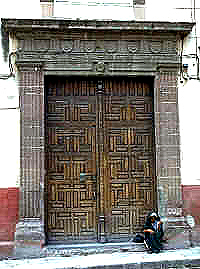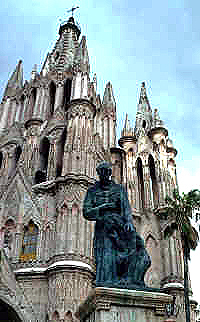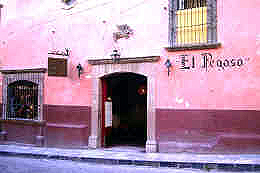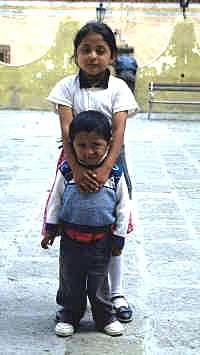Travel
Search
SAN MIGUEL DE ALLENDE |
|
Harlan Hague |
I love to fly. It's the arrangements that worry me. I suspect that Murphy is booked on my every flight. I always approach the check-in cautiously, prepared to do battle.
Take my trip to San Miguel. My flight arrived at Los Angeles four hours before the scheduled departure of the connecting Aeromexico flight for Leon. I decided to check in early. I have been a victim of overbooking and duplicate seat assignments more than once.
The agent took my ticket, stared hard at the computer terminal, then looked sadly at me. Murphy. My reservation, she said, had been canceled. It seems that my travel agent had not confirmed the flight. My spirits sank as I saw my holiday in San Miguel de Allende shortened by an enforced stopover in tinsel town.
Actually, I like Los Angeles, but not this way.
Another agent, noting my distress, came over and talked with my agent in rapid-fire Spanish. She punched something into the terminal and smiled. Not to worry. There were still seats available on the flight. Later, while waiting at the boarding gate, I was upgraded to first class. I had hardly settled into my wide Class Premier seat when the stewardess offered a glass of nice dry white wine. Murphy had missed the flight after all. Another glass of wine, and I loved Aeromexico.
I arrived in Leon at 11:00 p.m. Kurt, the son of the owner of the posada where I was booked was waiting for me. During the night drive to San Miguel, I marveled at my uncommon good sense in not renting a car when I saw a rental in front of us almost go airborne over one of the numerous speed bumps. Some are marked. Kurt also exhibited considerable skill in dodging the donkeys and dogs that wandered about on the road.
There is something to be said for arriving at a foreign destination at night. San Miguel was quiet. There was only an occasional car, hurrying to end the day. The dimly-lit plaza was empty, except for a man who walked slowly, hunched over. A gentle breeze disturbed the tree branches, making moon shadows dance about the pavements. The town was heavy with an aura of mystery that daylight would not erase.
The reality of San Miguel is no less attractive. The town was founded in the
mid-sixteenth century and reached its glory during the
Spanish colonial period that ended in 1821. Most of the structures in San Miguel date from
the seventeenth and eighteenth centuries, thus the designation of the town's architecture
and the town itself as "colonial." San Miguel's charm today is not by accident.
It was declared a National Monument in 1926, and architectural controls are tight. No neon
here, no steel and glass eyesores, and no traffic lights.
reached its glory during the
Spanish colonial period that ended in 1821. Most of the structures in San Miguel date from
the seventeenth and eighteenth centuries, thus the designation of the town's architecture
and the town itself as "colonial." San Miguel's charm today is not by accident.
It was declared a National Monument in 1926, and architectural controls are tight. No neon
here, no steel and glass eyesores, and no traffic lights.
The main plaza, called "the jardin" by locals, is the center of the historic district, serving as a hub for sightseeing and a respite for the weary. Manicured laurels shade wrought-iron benches and band kiosk. Ornate wrought-iron lamp posts complete the French aura of the jardin. Mornings, resident Americans occupy the "gringo bench," catching up and reading their newspapers. Bands often play in the evenings, most often a mariache.
La Parroquia towers over the jardin and the town. The Church of St. Michael the
Archangel could pass for a cathedral, but it is simply a parish church (parroquia), though by no means a simple church. While the
church was built in the seventeenth century, the distinctive facade was added at the
opening of this century. The neo-Gothic multi-towered facade, called "grotesque
gothesque" by detractors, is undeniably not colonial and more Disney than gothic.
While some decry the departure from traditional styles and groan about the violence done
to the colonial charm of the town, the Parroquia has become the visual symbol of San
Miguel.
(parroquia), though by no means a simple church. While the
church was built in the seventeenth century, the distinctive facade was added at the
opening of this century. The neo-Gothic multi-towered facade, called "grotesque
gothesque" by detractors, is undeniably not colonial and more Disney than gothic.
While some decry the departure from traditional styles and groan about the violence done
to the colonial charm of the town, the Parroquia has become the visual symbol of San
Miguel.
Built on a gently-sloping hillside, the town is compact and invites walking. Suitable
shoes are a requisite, as well as care to avoid a twisted ankle on the picturesque
cobblestones. Plaster and stone  buildings abut treeless
sidewalks, sometimes giving streets a sterile appearance in spite of colorfully decorated
facades. Behind the walls, there is another world. One has but to step through a heavy
door in the facade to enter an enclosed sunny courtyard softened by flowers and trees, the
sides shaded with colonnaded porches, often with a pretty fountain in the center. Doors of
restaurants and shops indeed are often left open to invite passersby into the cool green
courtyards.
buildings abut treeless
sidewalks, sometimes giving streets a sterile appearance in spite of colorfully decorated
facades. Behind the walls, there is another world. One has but to step through a heavy
door in the facade to enter an enclosed sunny courtyard softened by flowers and trees, the
sides shaded with colonnaded porches, often with a pretty fountain in the center. Doors of
restaurants and shops indeed are often left open to invite passersby into the cool green
courtyards.
La Parroquia is not the only church worth visiting. The seemingly constant pealing of bells confirms that San Miguel is a city of churches. The Church of San Francisco, notable for its uniquely Mexican Churrigueresque facade, is one block east of the jardin. The Oratorio of San Felipe Neri, one block north of San Francisco, is the favorite of San Miguelians. Originally founded by a mulatto congregation, the late seventeenth century building was expanded by a larger community who seized the church through legal process, or assimilated the founding mulattos, depending on one's interpretation of events. The baroque stone facade, displaying an Indian influence, was added in the eighteenth century.
The rather drab interior contains a series of paintings depicting the life of St. Felipe Neri. It also contains, to the left of the altar, the exquisite Santa Casa de Loreto. This replica of the Virgin Mary's house in Loreto, Italy, reputedly borne there from Nazareth by angels, is an early eighteenth-century baroque jewel. Just east of the church, the craft and vegetable markets are popular with both locals and tourists.
The Church and Convent of La Concepcion, once the largest religious complex in San Miguel, is located two blocks west of the jardin. The compound is topped by a monumental dome modeled after that of the Eglise du Dome of the Hôtel des Invalides in Paris. A two-storied portion of the convent surrounding a patio, one of the largest in colonial New Spain, is now Bellas Artes, a cultural center where classes are held in painting, music, language and other subjects. Huge ancient trees shade the patio and the fountain in the center. There is a small cafe in a corner of the ground floor. A relaxing tea break at one of the outdoor tables, shaded by the overhanging porch, must be one of the best kept secrets in San Miguel. Bellas Artes students undoubtedly would prefer that it remain so.
Three interesting churches outside San Miguel are worth the short trip. The little church at San Miguel Viejo--old San Miguel is now a corn field--is built on the site of Fray Juan de San Miguel's original mission, founded around 1540. The delicate painted stone ornamentation around the door shows Indian and Spanish influence. About ten miles north of San Miguel, the Atotonilco Sanctuary is a surprise. The formidable structure was a place of pilgrimage during the colonial period. The stunning screen and murals depict the lives of Christ and the saints.
Continue a few miles northward through an arid countryside, occasionally softened by
irrigated patches, to the village of Dolores Hidalgo. The Parish Church of Our Lady of
Sorrows is important more for historical than architectural or
religious reasons. It was from this church that Father Miguel Hidalgo y Costilla in 1810
raised El Grito de Dolores, the Cry of Dolores, which set off Mexico's revolt
against Spanish rule. After visiting the church, walk through the shaded plaza opposite to
the curbside ice cream sellers. Some San Miguelians pronounce their ice cream the best in
Mexico. They feature traditional and exotic flavors, including asparagus and tequila.
Taste the chile ice cream if you dare.
more for historical than architectural or
religious reasons. It was from this church that Father Miguel Hidalgo y Costilla in 1810
raised El Grito de Dolores, the Cry of Dolores, which set off Mexico's revolt
against Spanish rule. After visiting the church, walk through the shaded plaza opposite to
the curbside ice cream sellers. Some San Miguelians pronounce their ice cream the best in
Mexico. They feature traditional and exotic flavors, including asparagus and tequila.
Taste the chile ice cream if you dare.
The full name of San Miguel honors another hero of the War of Independence, Captain Ignacio Allende y Unzaga. His home, a mid-eighteenth century house with an interesting baroque facade, is adjacent to the Parroquia and the jardin. It is now a museum.
A number of other houses within walking distance of the jardin are worth visiting. The House of the Counts of la Canal, across the street from the jardin, is now a bank but with a little imagination one can still see this striking example of an eighteenth-century nobleman's home. The Inquisitioner's House, the residence of a commissioner of the Holy Office, is located two blocks south of the jardin. The house is noted for its delicate wrought-iron balconies and a French-influenced facade.
The lovely country mansion of Don Tomás de la Canal, about ten blocks southwest from the jardin, is famous today as the Allende Institute. The prestigious art and language school was founded in 1938 by Stirling Dickinson, the first prominent American to settle permanently in San Miguel. Dickinson's home on a hillside above the town is a gathering place for other resident Americans and tourists alike. He is a world-class authority on orchids and has the largest collection in Mexico. The gardens are open to the public, but inquire locally for opening times. Ask the cab driver for Los Pocitos, The Orchids.
Before leaving San Miguel, stroll through Juárez Park, due east of the Allende Institute. If you are lucky, you will see young boys practicing bull-fighting techniques with a horn-wielding accomplice. Just across the street on the east side of the park, the stone tubs of the outdoor public laundry are still in use.
Accommodation in San Miguel is comfortable, convenient, and for the most part, moderately-priced. Mexico is one of the few places in the world that is still a bargain for American travelers. Best for ambiance and value are the posadas. I stayed at Casa Carmen, just one block from the jardin. It is small, colonial style, with a sunny courtyard and colonnaded porches, punctuated with flowering plants and vines and a fountain in the center. The double price of $50 included breakfast and lunch. The cooking is Mexican and delicious. Telephone Natalie Mooring at (465) 2-08-44, or write to her at Casa Carmen, Correo No. 3l, A.P. 152, San Miguel de Allende, Guanajuato 37700, Mexico. Ask for a room off the street.
There are Mexican government tourist offices in many American cities. See your telephone directory or ask a travel agent for the address of the nearest office. In San Miguel, there is a tourist information office adjacent to the Parroquia.
|
Caveat and disclaimer: This is a freelance travel article that I published some time ago. Some data, especially prices, links and contact information, may not be current. |
|
|
|
|